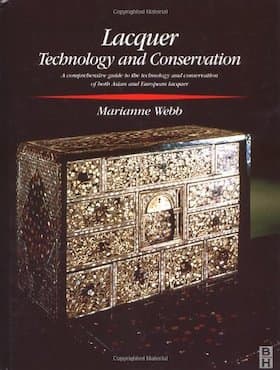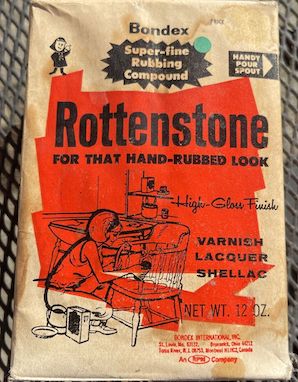
-----
Old Japanning Paint Recipe wanted
Q. I am trying to replicate the old japanning paint found on many antique tools. This type of finish was originally baked on, and is often referred to as Japan Black. One of the ingredients was aphaltum. I am looking for either a source of finished product, or a formula and some guidance to acquiring the raw materials and mixing. Any help would be greatly appreciated.
Thanks,
- Walled Lake, Michigan
2000
A. Tim, try this web site:
members.nbci.com/_XMCM/nlindsey/restoration/Restoration.htm
[Ed. note, link no longer works]
- Pensacola, Florida, USA
2001
Ed. note --
Readers: This site (on line for 31 years here in 2020, as a BBS for 6 years before the internet) tries to be a useful permanent reference in a world of endless broken links :-)
So, if you post a link, please include at least the title & author of the article (if not an abstract) so we can try to find the suggested articles when links break, which they usually do very quickly.
A. TIM S.:
ASPHALTUM IS ALSO A PRINTMAKING SUPPLY. AVAILABLE FROM PRINTING SUPPLY CO OR FROM A GOOD ART SUPPLY STORE THAT SELLS ETCHING SUPPLIES. IT COMES IN A CHUNK AND MELTS TO DRAW LIKE A CRAYON ON A WARMED PRINTING PLATE. HARDENS WHEN COOL AGAIN.
- SAN RAFAEL California USA
May 13, 2020
Q. I collect carpenter planes and would like to know more about a finish called japanning. What is it? How is it done and what makes up a "japanned" finish? Is there another name for this type of finish?
Thanks,
- Crystal Lake, Illinois
2001
on Amazon
or AbeBooks
(affil link)
A. I always thought of japanning as a bright and thick enamel finish. But I've never studied it.

Ted Mooney, P.E.
Striving to live Aloha
finishing.com - Pine Beach, New Jersey
Ted is available for instant help
or longer-term assistance.
A. There's some interesting non-commercial information on japanning at stanford.edu.

Bill Reynolds [deceased]
consultant metallurgist - Ballarat, Victoria, Australia
We sadly relate the news that Bill passed away on Jan. 29, 2010.
2001
A. A totally trivial fact: My grandfather operated a Japanning business in Newark NY in the early years of the last century. He was, according to his letterhead, J. Sutman, a Tinner and Japanner of Iron and Wood Work ..also Hard Rubber and Leather Finish Japanning. He was a very old man when I was born and I never had a opportunity to learn from him about his business. The only value of this information is to indicate that "Japanning" is a venerable finishing technique.
Joseph L. Sutman- Thousand Oaks, California
2003
A. I first heard about japanning on reading about Steinway grand pianos, made in New York. They used japanning to create the fine, glossy gold paint on the iron frames of the instruments towards the end of 19th and early 20th century. This is the part most visible when you raise the top of a grand piano and look inside.
Mr. Juha Huotari- Helsinki, Finland
2004
A. I restore antique cars as a hobby and have heard of japanning. In fact, 1924 was the last year japanned finishes were used on the Buick.
1925 was the first year they used Proxlin Lacquer. According to the books I've read about those old cars, japanning was a pigmented varnish. The fenders and splash aprons were always dipped with black paint (most likely japanned), but the bodies were sprayed the color for the specific body style and later the body was attached to the chassis which already had the fenders, etc. installed. (By 1928, most manufacturers allowed customers to choose from among 4 color schemes.) This same assembly technique was used by Ford and most other manufacturers at the time up until unibody construction.
- Orem, Utah, USA
2005
Q. I have collected several old Stanley wood planes made of cast iron. I would like to put a new coating of Japan Black on them. I cannot find the lacquer or varnish anywhere. Does anyone have the recipe?
Dick Partinhobbyist - Valparaiso, Indiana, USA
2007
A. 1926 Harvard School of Engineering copy of "Iron Age" from 1915 led me to term Japaning, which led me to info on "Pontypool japan", a process intended to compete with (then) new plating methods for protecting iron.
Here is link for "IRON AGE" journal article.
Here is the link to the Pontypool Japan article.
Other recipes are out there, I am certain a little more digging might yield additional results or clues.
Please advise if I might be of assistance - always interested to dig around for odds and ends about history.
- Richmond, Ohio, United States of America
June 10, 2013
January 14, 2014
A. Imitation japanning finish is:
One part part Mahogany varnish stain and Two parts Walnut varnish stain. Coat and dry to get depth of color wanted.
Or
Cold cure Japanning
Recipe of Stephen Shepherd
Use roofing tar (it is asphaltum in USA), let the volatiles evaporate, then mix it up with marine spar varnish (gloss). Put it on wood or metal and it is durable. Prepare the surfaces first with Alcohol to remove grease and oil etc. Surface prep is important. You can cure it at 220 °F for about a 1/2 hour in oven. Do not use your house oven as the vapors are dangerous. If you air dry it will take 8 to 24 hours to dry good and will get harder with time. Gives the black brown color of old days and you can re-coat to get the desired color depth. Good Luck.
Welding instructor - Waycross, Georgia, USA
A. I have found some recipe's in an old book called;
Workshop Receipts for the use of manufacturers, mechanics & scientific amateurs.
By Ernest Spon (London and NewYork) published in 1879.
Page 66-67 deals with black paint for iron. I think this is what you are looking for, good luck finding the book, could try the scribd website also.
Good luck
- South UK
June 17, 2014
A. Pontypool Japan paint is offered by Liberty on Hudson,
www.LibertyOnTheHudson.com/pontypool.html
A full plane restoration process is posted at
mvflaim.wordpress.com/2011/07/24/re-japanning-a-plane/
- Gaylordsville, Connecticut - USA
January 2, 2018
Sensational writing, very helpful - thank you.
Q. Can I get Japan Black's recipe?
Could someone help me?
I am Hungarian. I was looking for that Japanese Black ink everywhere in Europe, but it's impossible to buy one. I do not dare to order, because I am afraid the transport would be more expensive than the paint itself - which is quite expensive anyway.
Any idea, solution interested if someone could help ...
Thank you in advance --JR --from Hungary
-- - Budapest, Hungary
March 27, 2019
A. Try Internet archive website there you can find many download free old paints and inks technology books (https://archive.org/details/inkstheircomposi00mitcrich/page/n4?q=inks). Hope it helps and good luck!
Goran Budija- Zagreb,Croatia
March 29, 2019
Q. Thanks Goran the quick answer.
I started to search in the table contents but I hadn't found I did not find a Japanese Black recipe and nothing at all any bitumen base paint for metal surfaces.
Otherwise the book is super, thank you very much.
Just today I have learned that all asphalt and bitumen as a dye in the EU is forbidden. That's shocking.
Do you think that the Japanese Black paint its available in Croatia? I could order it faster from there.
- Budapest, Hungary
March 30, 2019
A. According To Henleys Twentieth Century Formulas Processes and Trade Secrets
https://archive.org/details/henleystwentieth00hiscrich/page/n8
-- page 406. China, India or Japan Ink is based on lamp black pigment (German firm Kremer Pigmente sells it in EU and USA).
A. Handbook on Japanning, download free book
https://archive.org/details/in.ernet.dli.2015.32452/page/n5?q=japanning
Hope it helps and good luck!
- Zagreb,Croatia
April 5, 2019
![]() Thank you Goran -- these books are great helps! I found the recipe on the page 497.
Thank you Goran -- these books are great helps! I found the recipe on the page 497.
Thank you
- Budapest, Hungary
April 7, 2019
A. I received a can of asphaltum from an art supply outlet in Washington, D.C. years ago. It is used for metal plate preservation and for munitions manufacturing. You can research those uses. I refinished metal working tools (mostly planes), some old pipe wrenches, some cast iron plumb bobs, and a few hammers and hatchets. I used the thin tar material straight from the can and had no mixing, dissolving, heating, etc.
The cleaning and protection of non-involved surfaces constituted the most tedious work. The end results have been very satisfying. The look is more like original black coating than a restored look having time created patina.
- James Creek, Pennsylvania
July 29, 2019
Q. I would like to do some restoration work that includes a variant on japanning called Crystal Japan. It is oven-finished and produces a very specific texture (but not wrinkle) finish, always in black and found on old instruments and cameras. Does anyone know how this is done and the material constituents?

photo and cine historian - Omaha, Nebraska, USA
September 11, 2019
A. Try archive.org website; there you can find many old photography handbooks, most of the books are downloadable for free.
"Photographic facts and formulas" by Wall, E. J. ( https://archive.org/details/photographicfact00wall ) is probably a good starting point ... Hope it helps and good luck...
- Zagreb,Croatia
September 24, 2019
? That's a book of photographic formulae. It does not have information on industrial metal finishes.
Michael Cleveland [returning]photo and cine historian - Omaha, Nebraska, USA
October 2, 2019
A. Yes, but there are many other older books on that subject, some of them with chapters on metal finishes used on photographic equipment. Industrial finishes are patent protected -- in that case try uspto.gov webpage...
Page 6 of Photographic facts and formulas: recipe for coloring aluminum black, and recipe for black paint for cameras.
Page 4 recipe how to blacken wood.
Page 5 recipe how to blacken brass.
Hope it helps and good luck!
- Zagreb,Croatia
October 8, 2019
a Liberty on the Hudson appears to be one of the providers of Japanning Paint and other coatings for restoring finishes on old tools and other antique items. They sell a black Pontypool Japanning Asphaltum Paint, this link leads to their information page explaining Japanning and the paint they sell. The paint is very expensive but a quart will coat dozens of tools and should last for years.
https://libertyonthehudson.com/pontypool.html
- Ripon , Wisconsin USA
November 5, 2019
You can find japanning mixtures, techniques and helpful hints in my article:
https://aplanelife.us/blogs/f/japanning-or-the-art-of-embracing-the-arcane
GoSeeLife.com - Alexandria, Virginia USA
December 18, 2019
A. One way to make an old-style black lacquer is:
* Take a scrap/scratched non valuable 78 rpm old record.
* fold it inside a tea towel and smash it with a hammer
into small pieces.
* dissolve the pieces in a bath of methylated spirit
⇦ on
eBay or
Amazon [affil link]
. (Might take a day or two to completely dissolve.
* Add some french polish.
* Add some gas/lamp black, ie fine soot. To make you can use an old blow torch, yellow flame against a piece of tin should make black soot.
Apply to wood with brush or rubber. (cotton wool inside cloth).
When totally dry/hard Burnish with burnishing cream or marble block covered in leather using water and rottenstone.
Should produce a nice black finish that does NOT look too new.
- United Kingdom of Great Britain
April 28, 2020
Q, A, or Comment on THIS thread -or- Start a NEW Thread

